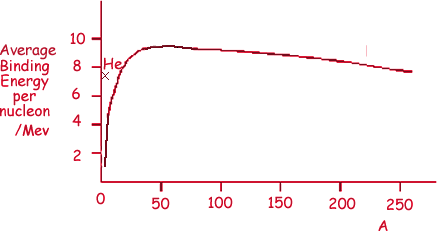Nuclear Fission
Q5.
(a)
(i) Explain what is meant by the term binding energy for a nucleus.
Binding energy is the work done on the nucleons in a nucleus to separate those nucleons completely from one another. 

Binding energy is the energy released by nucleons when nucleus is formed from separated nucleons. 
(ii) Sketch on the axes above, a graph of the average binding energy per nucleon against nucleon number A, giving approximate values of the scale on each axis.

curve: correct shape, maximum at A between 40 – 60  sharp rise from <50
sharp rise from <50  gradual fall to > 60%
gradual fall to > 60%
scales: binding energy per nucleon to 8 – 10 MeV  A to > 220
A to > 220 
(5 marks)
(b) Use your graph to explain why energy is released when a neutron collides with a  nucleus causing fission.
nucleus causing fission.
(2 marks)
(c) Neutrons are released when nuclear fission occurs in U .
.
Some of these neutrons induce further fission, others are absorbed without further fission and others escape from the surface of the material.
The average number of neutrons released per fission is 2.5, of which at least one must produce further fission if a chain reaction is to be sustained.
Explain how a chain reaction can occur only if the piece of uranium has a certain minimum mass (the critical mass).
(3 marks)
(Total 10 marks)


